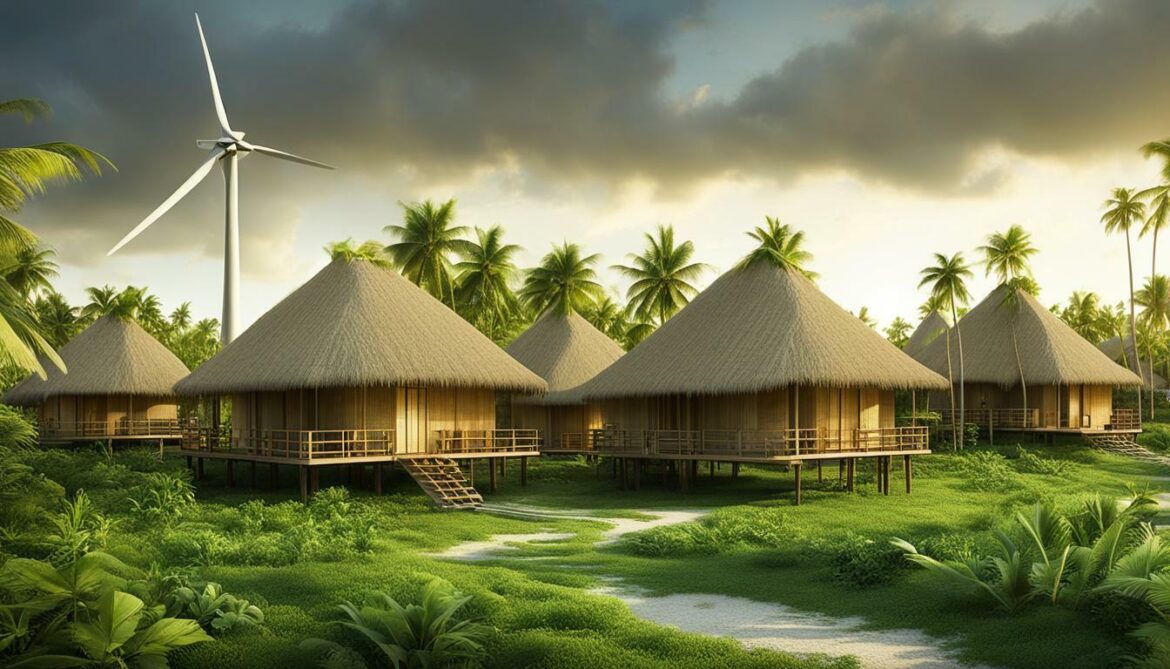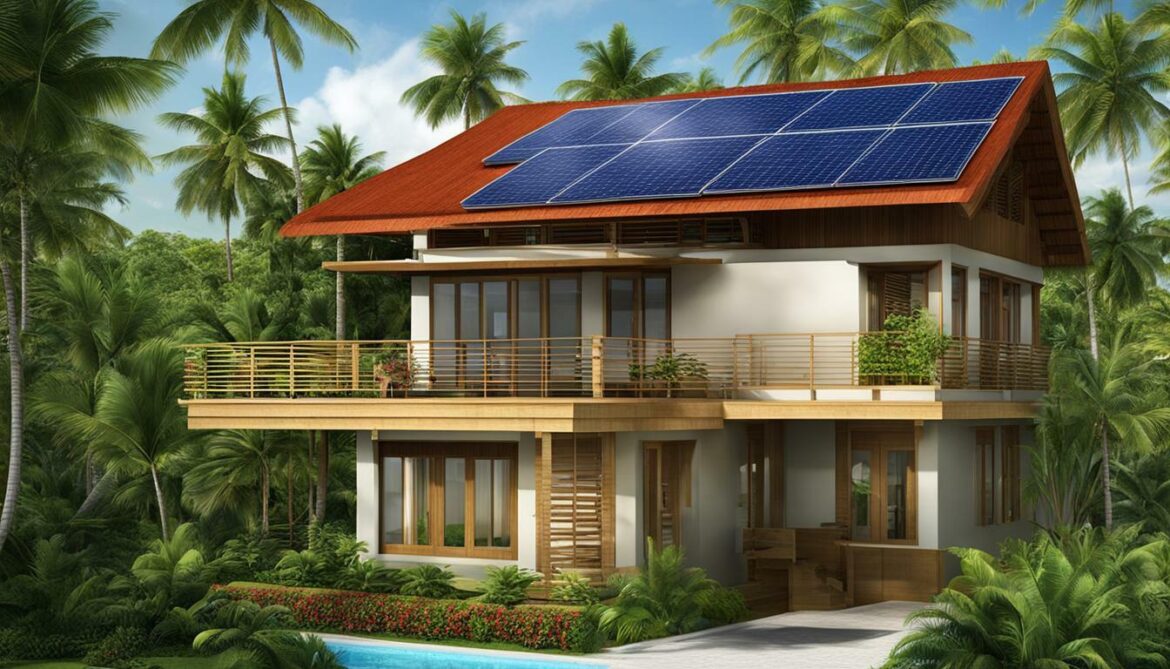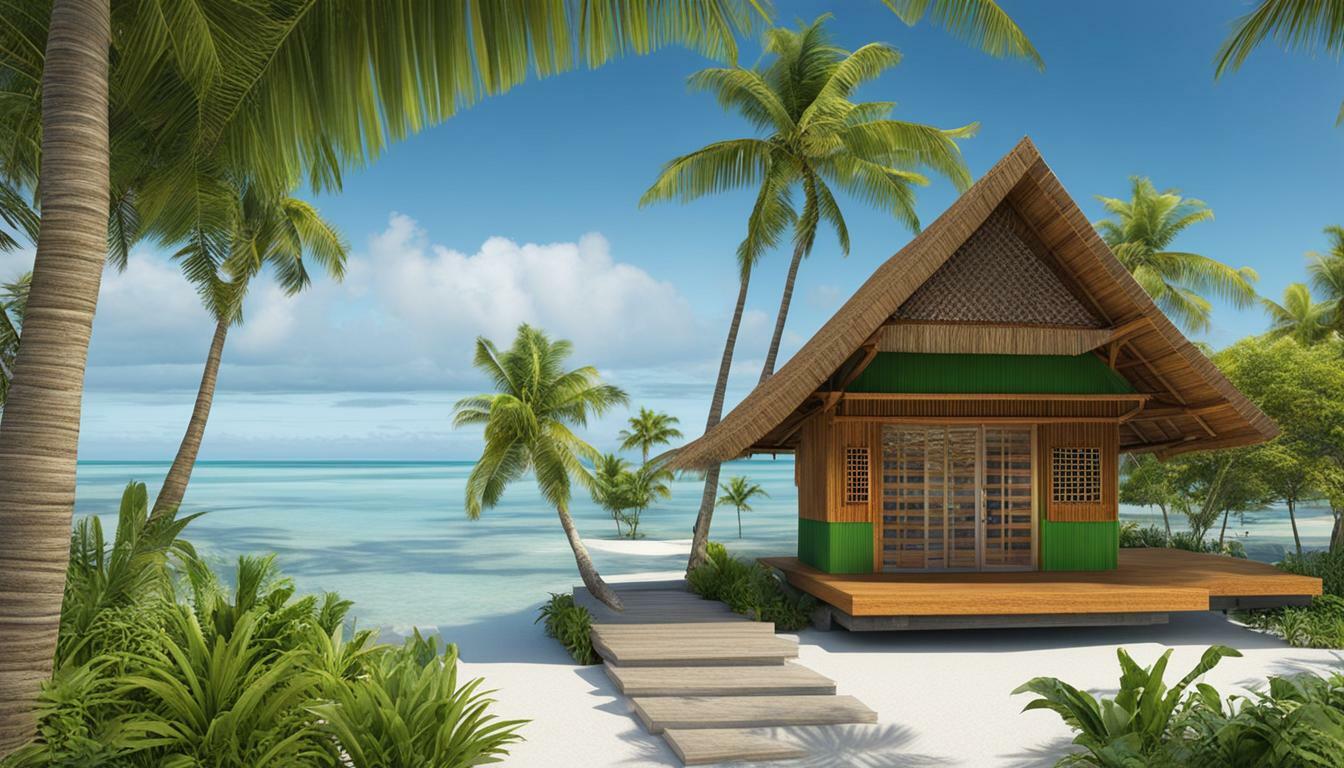Kiribati’s green building history is a testament to the nation’s commitment to sustainable development amidst the challenges posed by climate change. As a low-lying Pacific island nation, Kiribati faces the imminent threat of rising sea levels due to global warming. With its entire territory below two meters above sea level, the country is at risk of being the first to be swallowed up by the sea as a result of climate change.
Storm surges and high tides have already caused flooding, contaminating freshwater reserves and destroying crops. Faced with such vulnerabilities, Kiribati has taken proactive measures to address these challenges through eco-friendly building practices and sustainable architecture.
Key Takeaways:
- Kiribati, a low-lying Pacific island nation, is facing the threat of rising sea levels due to global warming.
- The entire territory of Kiribati is below two meters above sea level, making it highly vulnerable to climate change.
- Storm surges and high tides have caused flooding, damaging freshwater resources and crops.
- Kiribati’s commitment to sustainability is evidenced through its green building practices and sustainable architecture.
- The country’s green building history serves as a warning for other coastal regions facing similar threats.
The Urgency of Sustainable Development in Kiribati
With Kiribati’s low-lying geography and the increasing threat of rising sea levels, sustainable development has taken on a crucial role in ensuring the resilience and survival of the nation. As a small Pacific island nation, Kiribati is facing the devastating consequences of climate change, with the risk of being the first country to be completely submerged by the sea. The urgency of the situation calls for immediate action in adopting green construction methods and prioritizing sustainable development.
Kiribati’s vulnerability to climate change is evident in the frequent flooding caused by storm surges and high tides, which have already contaminated freshwater reserves and destroyed crops. The impacts of rising sea levels pose significant challenges to the country’s social, economic, and environmental stability. Recognizing the gravity of the situation, former president Anote Tong has been a vocal advocate for reducing greenhouse gas emissions to mitigate the effects of climate change.
One of the key strategies embraced by Kiribati is the promotion of sustainable construction practices. By prioritizing eco-friendly building methods, the nation aims to reduce its carbon footprint and enhance its resilience to climate change. Sustainable architecture and green building initiatives play a vital role in minimizing energy consumption, conserving natural resources, and enhancing the overall sustainability of Kiribati’s infrastructure.

Kiribati’s Innovative Sustainable Architecture
Kiribati’s commitment to sustainable architecture is evident in its pioneering use of eco-friendly building practices and innovative designs that harmonize with the natural environment. As a low-lying Pacific island nation facing the threat of rising sea levels, Kiribati recognizes the urgent need to adapt to climate change and minimize its carbon footprint. Through sustainable architecture, Kiribati aims to create resilient and environmentally-conscious buildings that can withstand the challenges posed by a changing climate.
One example of Kiribati’s innovative sustainable architecture is the use of locally-sourced materials in construction. By utilizing materials that are readily available on the island, such as timber and coral, builders can reduce the need for imported materials and lower the carbon emissions associated with transportation. This approach not only promotes sustainability but also supports the local economy by creating jobs and stimulating the demand for local resources.
In addition to the use of local materials, Kiribati embraces traditional design elements in its sustainable architecture. By incorporating traditional building techniques, such as raised platforms and natural ventilation systems, architects can create buildings that are better adapted to Kiribati’s tropical climate. These design features promote energy efficiency, minimize the reliance on artificial cooling systems, and reduce the overall environmental impact of the buildings.

The efforts towards sustainable architecture in Kiribati extend beyond individual buildings. The country also focuses on creating eco-friendly communities that prioritize environmental conservation and promote a sustainable way of life. This includes the development of green spaces, efficient waste management systems, and the integration of renewable energy sources into the infrastructure.
| Benefits of Kiribati’s Sustainable Architecture |
Examples |
| Reduced carbon footprint |
Use of locally-sourced materials |
| Energy efficiency |
Incorporation of natural ventilation systems |
| Environmental conservation |
Development of green spaces |
| Resilience to climate change |
Integration of renewable energy sources |
Kiribati’s innovative sustainable architecture sets an example for other coastal regions facing similar threats from climate change. By prioritizing eco-friendly building practices, utilizing local resources, and embracing traditional design elements, Kiribati demonstrates that it is possible to create resilient and environmentally-conscious buildings that harmonize with the natural environment. The country’s commitment to sustainable development serves as an inspiration for a greener and more sustainable future.
Eco-Friendly Building Practices in Kiribati
Kiribati’s eco-friendly building practices encompass a range of sustainable strategies, from the use of renewable materials to the implementation of energy-efficient systems that minimize environmental impact. As a low-lying Pacific island nation facing the threat of rising sea levels due to climate change, Kiribati recognizes the importance of prioritizing eco-friendly construction methods.
One key aspect of Kiribati’s sustainable building practices is the utilization of renewable materials. Local resources such as coconut timber and thatch are commonly used in construction, reducing the need for imported materials and supporting the local economy. These natural materials not only have a lower environmental impact but also offer excellent insulation properties, keeping buildings cool in the tropical climate.
Furthermore, Kiribati emphasizes the implementation of energy-efficient systems to reduce carbon emissions. Buildings are designed with proper ventilation and natural lighting in mind, reducing the need for artificial cooling and lighting. Rainwater harvesting systems and solar panels are also widely adopted to minimize reliance on imported resources and promote self-sustainability.
Efforts are also made to manage and reduce waste. Recycling initiatives are encouraged, and construction waste is carefully handled to minimize its impact on the environment. By adopting these eco-friendly building practices, Kiribati aims to mitigate the effects of climate change and create a more sustainable future.
| Eco-Friendly Building Practices in Kiribati |
Benefits |
| Utilization of renewable materials |
– Lower environmental impact
– Supports local economy
– Excellent insulation properties |
| Implementation of energy-efficient systems |
– Reduces carbon emissions
– Decreases reliance on imported resources
– Promotes self-sustainability |
| Waste management and reduction |
– Promotes recycling initiatives
– Minimizes environmental impact
– Responsible handling of construction waste |
Government Initiatives for Green Building in Kiribati
The Kiribati government has played a vital role in promoting green building practices and sustainable development, recognizing the urgency of addressing climate change in the nation’s architectural landscape. With the threat of rising sea levels and the vulnerability of its low-lying islands, Kiribati has taken proactive measures to adopt eco-friendly construction methods and policies.
One of the key initiatives by the government is the promotion of sustainable architecture in Kiribati. By encouraging the use of locally-sourced materials and traditional design elements, the country is able to create sustainable buildings that are not only environmentally friendly but also culturally significant. These sustainable architectural practices prioritize energy efficiency and environmental conservation, contributing to the overall resilience of the nation in the face of climate change.
“Sustainable architecture in Kiribati is not just about building structures that are resilient to climate change; it is also about preserving our cultural heritage and way of life,” says Teburoro Tito, the Minister of Environment, Lands, and Agricultural Development.
In addition to sustainable architecture, the government has also implemented eco-friendly building practices in Kiribati. This includes the use of sustainable building materials, such as locally-produced bamboo and coconut timber, which are renewable resources. The construction industry in Kiribati has also embraced efficient energy systems, such as solar panels and rainwater harvesting, to reduce reliance on fossil fuels and minimize waste.
The Kiribati government’s commitment to green building practices aligns with its vision for sustainable development in the face of climate change. By prioritizing eco-friendly construction methods and policies, Kiribati is setting a positive example for other coastal regions dealing with similar challenges. Through international collaborations and partnerships, the nation is able to share its expertise and learn from others, further driving progress in sustainable construction.

International collaborations have been instrumental in supporting Kiribati’s sustainable construction efforts, with organizations and foreign partners lending expertise and resources to promote environmentally-friendly building practices. With the urgent need to mitigate the effects of climate change and rising sea levels, collaborations have played a crucial role in implementing innovative solutions in Kiribati.
One such collaboration is the partnership between the Kiribati government and international NGOs, such as Greenpeace and WWF. These organizations have been actively involved in promoting sustainable architecture and eco-friendly building initiatives in Kiribati. Through their expertise and technical assistance, they have helped in designing and constructing buildings that are resilient to climate change impacts and utilize renewable energy sources.
Foreign assistance has also played a significant role in supporting sustainable construction projects in Kiribati. Countries like Australia and New Zealand have provided financial aid, technical expertise, and training programs to enhance local capacity in eco-friendly building practices. This assistance has enabled the adoption of sustainable building materials, energy-efficient systems, and waste management strategies to reduce the carbon footprint in Kiribati.
| Benefits of International Collaborations |
Examples |
| Exchange of knowledge and expertise |
Joint workshops and training programs on sustainable construction |
| Access to funding and resources |
Financial aid for green building projects and procurement of sustainable materials |
| Global networking and partnerships |
Collaboration with international organizations for sustainable development initiatives |
Building a Sustainable Future Together
The collaborative efforts between local stakeholders, international organizations, and foreign partners have been crucial in advancing sustainable construction practices in Kiribati. By combining traditional knowledge with modern innovations, Kiribati has been able to design and construct buildings that are adaptable to the changing climate conditions.
“The partnerships we have formed with international organizations and foreign assistance have been invaluable in our journey towards sustainable development. Together, we are building a future where our buildings are resilient, energy-efficient, and environmentally friendly.” – President of Kiribati
However, it is important to note that the challenges faced by Kiribati in achieving sustainable construction are ongoing. The scale of adaptation required to combat the effects of climate change requires continuous support and collaboration from the international community.

In conclusion, international collaborations have played a vital role in supporting Kiribati’s sustainable construction efforts. By sharing knowledge, providing resources, and fostering partnerships, these collaborations have contributed to the development of eco-friendly building practices in Kiribati. Moving forward, it is essential to continue these partnerships and cultivate new ones to ensure a sustainable future for Kiribati and other coastal regions facing similar climate change challenges.
Conclusion
Kiribati’s green building history serves as an inspiring example of sustainable development, highlighting the importance of environmentally friendly construction practices and the urgent need to address climate change in vulnerable coastal regions. Situated on a low-lying Pacific island, Kiribati faces the imminent threat of rising sea levels due to global warming. With its entire territory below two meters above sea level, the country is at risk of being the first to succumb to the sea’s relentless advance.
Already, Kiribati has experienced the devastating consequences of climate change, with storm surges and high tides causing flooding, contaminating freshwater reserves, and destroying vital crops. Former president Anote Tong has been a vocal advocate for reducing greenhouse gas emissions and has even acquired land in Fiji as a potential evacuation site for Kiribati’s displaced population.
The urgency of the situation in Kiribati should serve as a warning for other coastal regions facing similar threats. The country’s commitment to green building practices showcases the innovative solutions and sustainable architecture that can be implemented to mitigate the effects of climate change. From locally-sourced materials to efficient energy systems, Kiribati’s eco-friendly building initiatives prioritize reducing the carbon footprint and preserving natural resources.
As Kiribati continues to tackle the challenges posed by rising sea levels, the government has sought assistance from Australia and New Zealand for open migration of its displaced people. While New Zealand has responded to this call, the international community must rally together to support sustainable construction projects and foster collaborations that can protect vulnerable coastal regions like Kiribati. By learning from Kiribati’s green building history and taking action now, we can work towards a more sustainable future for all.
FAQ
What is the threat that Kiribati faces?
Kiribati is at risk of being the first country to be swallowed up by the sea due to rising sea levels caused by climate change.
How has climate change affected Kiribati?
Climate change has resulted in storm surges and high tides, causing flooding, contaminating freshwater reserves, and destroying crops in Kiribati.
What measures has Kiribati taken to address the threat?
Former president Anote Tong has advocated for increased efforts to reduce greenhouse gas emissions and has even purchased land in Fiji as a potential evacuation site. The Kiribati government has also sought assistance from Australia and New Zealand for open migration of displaced people.
Which countries have responded to Kiribati’s request for assistance?
Only New Zealand has responded to Kiribati’s request for assistance, while Australia is yet to take any action.
What can other coastal regions learn from Kiribati’s situation?
The urgency of the situation in Kiribati serves as a warning for other coastal regions facing similar threats from climate change, highlighting the need for immediate action to mitigate the effects of rising sea levels.
Source Links






















Post comments (0)